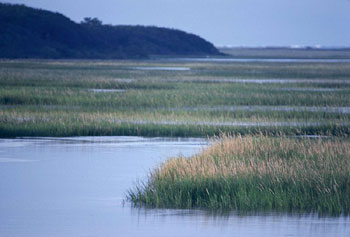Communities can reap big rewards by restoring reefs, estuaries, and other wetlands, protecting both people and their local economies, as well as crucial wildlife habitat.
While the environmental benefits are well known and accepted, most aren’t as aware that the economic benefits are just as compelling.
"There’s a direct connection between what we’re doing to enhance the environment and what we’re doing to enhance economic opportunity," says Mark Schaefer, Assistant Secretary of Commerce for Conservation and Management at the US National Oceanic and Atmospheric Administration (NOAA).
Indeed, "every $1 invested in wetland restoration generates at least $15 for industries like recreation, fishing, real estate, and tourism, while filtering pollution and protecting coastal communities from extreme weather and flooding." And every $1
million invested in coastal restoration creates an average of 17 jobs, in contrast to 8.9 jobs for the same money in offshore oil and gas development. That’s the conclusion of "Economic Benefits of Restoring Coastal Ecosystems," from the Center for American Progress and Oxfam America.

They studied by 3 coastal restoration projects funded by NOAA through the 2009 Recovery Act (Stimulus Bill): oyster reef and sea grass restoration project in the Seaside Bays, Virginia; an oyster reef project in Mobile Bay, Alabama; and salt marsh restoration in San Francisco Bay, California.
Economic Benefits come from:
- healthy fish populations: many rely on wetlands for nurseries and 75% of US commercial fish species need them during their life cycle;
- protection from storm surges saves billions of dollars a year in storm cleanup costs: 60% of Gulf Coast flooding could be prevented if wetlands were there to act as a barrier;
- coastal recreation opportunities like canoeing, kayaking and bird-watching;
- enhanced property values – people are willing to pay much more to live near intact ecosystems
- carbon sinks: coastal sea grass stores more carbon per square kilometer than forests do as they absorb excess nitrogen and phosphorus from fertilizer run-off, keeping groundwater clean for drinking.
Three Projects
In Virginia, restoring oyster reefs and underwater seagrass beds provided the critical habitat needed to clean the water and protect young fish. Such simple measures make all the difference for the commercial fishing industry – which has provided livelihoods to area residents for generations – and the revived coast attracts ecotourism and recreational fishing, a key focus for local economic development in a community with a 22.4% poverty rate.
San Francisco Bay, the largest estuary on North America’s Pacific coast, has lost 90% of its wetlands to agriculture, urban and suburban development, and commercial salt production. Efforts are underway at the local, state and federal levels to reverse this, purchasing over 27,000 acres since 1994. Under a 50-year regional plan, 50-90% of the Bay will be returned to salt ponds – the largest tidal marsh restoration effort in the western US.
Alabama’s Mobile Bay, part of the Gulf Coast shoreline, is an estuary of national significance, supporting nationally important bird, fish, and other wildlife species. Restoring oyster habitat created a vertical reef break that stabilizes the shoreline, making it possible to withstand and recover from storm surges.
"Investing in coastal restoration is good policy. It’s not just the right thing to do for the environment; it’s the right thing to do for coastal communities, vulnerable coastal populations, and the U.S. economy," say the authors. They call on Congress to enact and fund a National Endowment for the Oceans to provide a steady revenue stream for coastal restoration.
800 shovel-ready projects could get underway tomorrow if adequate investment becomes available. There’s lots of work to do and satisfying jobs to be created in restoring the more than 80,000 acres lost in the US every year.
If you are interested in keeping with this subject, check out Restore America’s Estuaries.
The US Fish and Wildlife Service also released an economic analysis, Restoration Returns: The Contribution of Partners for Fish and Wildlife Program and Coastal Program Project to Local U.S. Economies with a visual summary.
Check out their National Wetlands Inventory website, which for the first time maps every US wetland:
